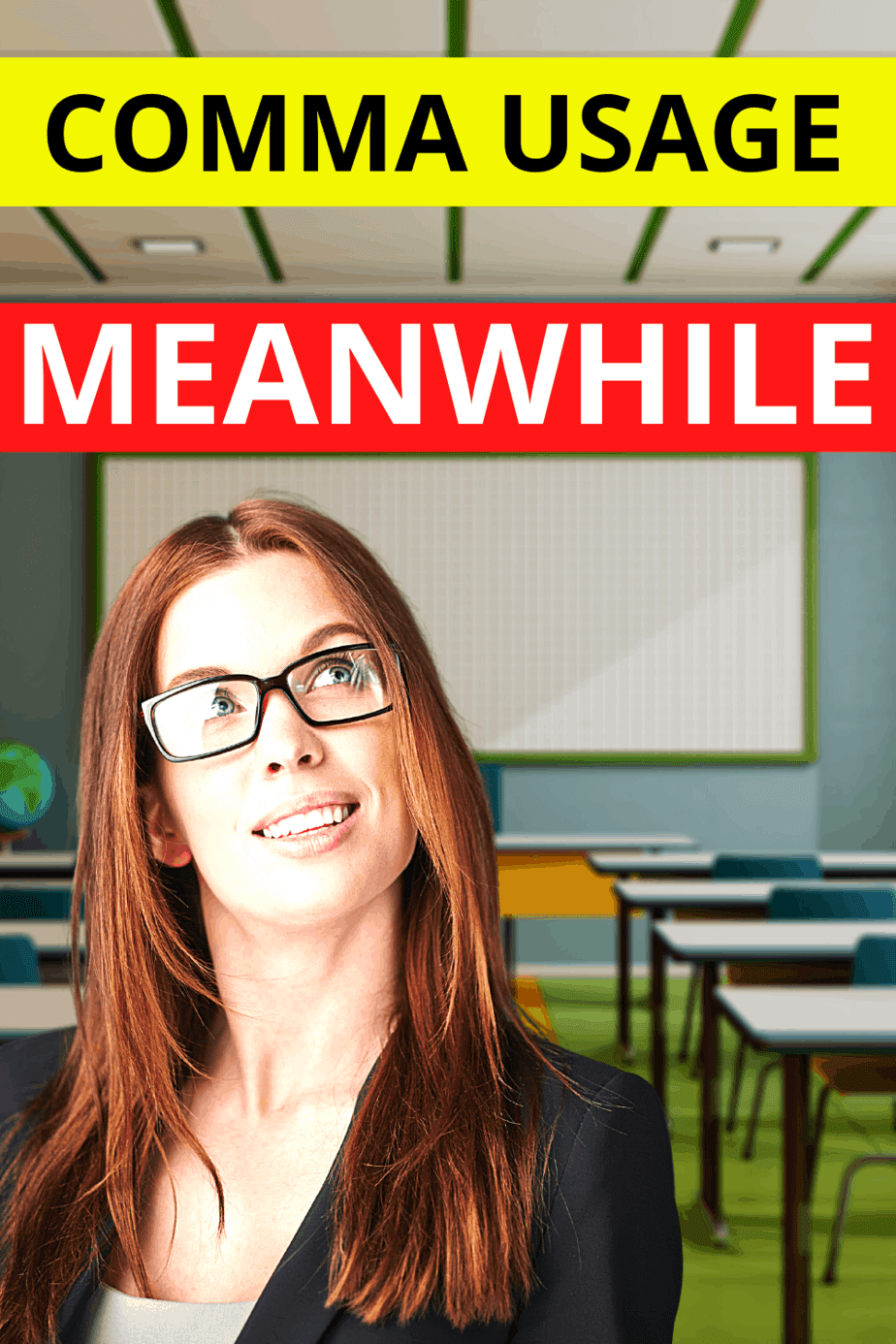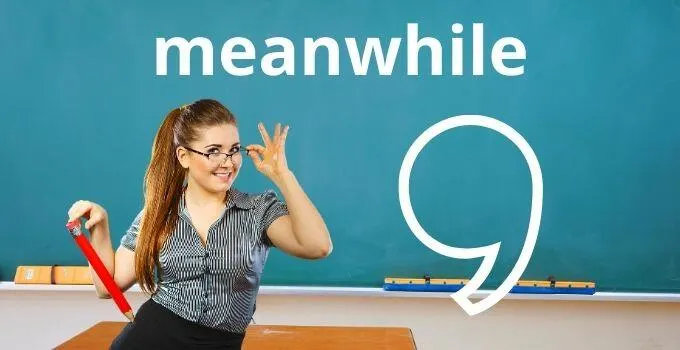Imagine a world where punctuations and cohesive devices do not exist.
It must be quite easy to pass our grammar-based assessments with flying colors.
However, it must also mean that written texts will be crowded, monotonous, and nonetheless illogical.
Therefore, it is needless to say that non-lexical symbols or punctuation marks, altogether with cohesive devices such as conjunctive adverbs are equally useful in texts.
Does a comma come before or after “meanwhile”?
Straightforwardly speaking, the answer to the question is dependent on its sentence placement and function. A comma may be placed before meanwhile when it is used as an initial parenthetical element in the sentence.
On the flip side, a comma may come after it when it serves as an introductory word to a clause, a final parenthetical component. Commas on both sides of meanwhile are also needed to offset this word as a single parenthetical unit.
Lastly, no commas should come on either side if it functions as a restrictive temporal adverb on any part of the sentence.

Comma before “meanwhile”
Meanwhile is an adverb with a temporal denotation or time-related meaning.
It has a similar sense to “meantime” which is used when intervening events occur extensively for a while or at the same time.
There are two cases wherein a comma would be needed before meanwhile.
As briefly mentioned earlier, parenthetical elements, when used in a statement, require pre-and-post-comma placements.
Parentheses are stylistic speech elements that aim to persuade, clarify, or explain another sentence component, such as the subject.
These expressions may be viewed from the reader’s perspective either as accidental or intentional thoughts that are peripherally inserted.
Since these elements are additive and superficial, they can be chopped off, yet they won’t paralyze sentence grammaticality.
Albeit dispensable, parentheticals are salient in creating aesthetic effects on the text which could meanwhile imply a writer’s linguistic eloquence.
After all, despite the collaborative effort of both the architect and engineer, a building would still exude more exquisiteness with an interior designer.
Meanwhile as an initial parenthetical element
We typically use meanwhile to describe another event occurring at the time of the utterance or at the time implied by the sentence.
Since meanwhile is an adverb, it can be generally followed by a verb, adjective, or another adverb.
When meanwhile is utilized as an initial parenthetical word, a comma should automatically be hooked before it
Comma after “meanwhile”
A statutory comma is expected to be placed after meanwhile in the two major cases explained in this section.
These cases occur when meanwhile functions as an introductory word (conjunctive adverb), and a final parenthetical element.
Meanwhile as an introductory word
Adverbs that may act as idea connectors are called adverbial connectors or conjunctive adverbs.
As the terms above suggest, these are adverbs with a conjunctive function.
The only difference between adverbial connectors and conjunctions is the flexibility of the former.
While both cohesive devices can logically connect ideas, conjunctions cannot modify other parts of speech as adverbs do.
Adverbial connectors, in contrast, may modify verbs, adjectives, and other adverbs.
When meanwhile is used conjunction-like at the beginning of a sentence, it requires a comma directly after it.
It can also be used as a second clause introductory word which can be preceded by a semicolon instead of a comma.
Meanwhile as a final parenthetical element
Although this case may happen rarely, a comma placement after meanwhile will be necessary if it is used as the last parenthetical unit.
As carefully elaborated in the earlier sections, meanwhile is generally used similarly to “meantime” as an adverb that denotes time.
Meanwhile, albeit infrequently, may be used to replace “meantime” in the phrase “in” or “for the meantime”.
This also means that when used this way, its part of speech changes into a noun, which is more specifically an object of a preposition in the mentioned phrases.
When this happens, meanwhile may be utilized as a final parenthetical component which, in turn, needs a comma placement afterward.
When is a comma necessary before and after “meanwhile”
A parenthetical device may also be composed of a single word only.
When this stylistic strategy is done with meanwhile, mandatory commas before and after have to offset the interrupter from the whole sentence.
Meanwhile as a single-word parenthetical element
The example below uses meanwhile as a single-word rhetoric word rather than a phrase or a clause.
A comma must be placed before meanwhile when it is used alone, and definitely after it as well.
To note once again, this parenthetical may be removed without lacerating the grammaticality of the sentence.
Hence, it is mainly inserted for effect and emphasis.
When is a comma not necessary before or after “meanwhile”?
Now that we already know the rules dictating comma placement before or after meanwhile, here are a few more guidelines directing when commas are unnecessary.
Meanwhile in the initial position
When meanwhile is used together with other lexical units at a sentence’s introduction, the comma must come after the last introductory word instead.
In this sentence type, meanwhile is treated as an indispensable element which means its usage is directly essential to the clause or phrase it belongs.
Meanwhile in the middle position
As a temporal adverb, meanwhile can also be inserted mid-sentence and function as a verb, adjective, or adverb modifier.
No commas have to be placed when the usage of meanwhile is, again, restrictive or essential to the meaning of the whole sentence.
Meanwhile in the final position
Referring back to the previous section explaining the possibility of using meanwhile as a replacement to “meantime”, we may similarly use it at the end of the sentence without a prior comma.
Although this position less likely occurs than the initial and middle positions, this would still constitute a perfectly grammatical sentence.
According to the Merriam-Webster online dictionary, the nominal usage of both meanwhile and meantime has been going on since the 1300s.
Therefore, there’s no need to worry if you have been using meanwhile rather than meantime in prepositional phrases because they are perfectly interchangeable.
Disheartened by the news, I have decided to turn the TV off in the meanwhile.
Conclusion
A writer’s ability to appropriately use punctuations and cohesive devices elicits a plethora of both linguistic competency and flexibility.
Although not all would agree to study this area comprehensively, we can’t deny that good writing would always remain a highly effective communication strategy.
Hence, the role of punctuations and cohesive devices should not be taken for granted.

Hey fellow Linguaholics! It’s me, Marcel. I am the proud owner of linguaholic.com. Languages have always been my passion and I have studied Linguistics, Computational Linguistics and Sinology at the University of Zurich. It is my utmost pleasure to share with all of you guys what I know about languages and linguistics in general.

